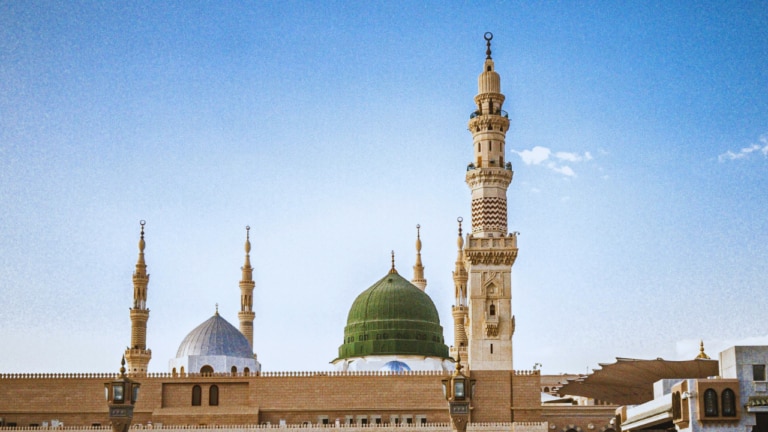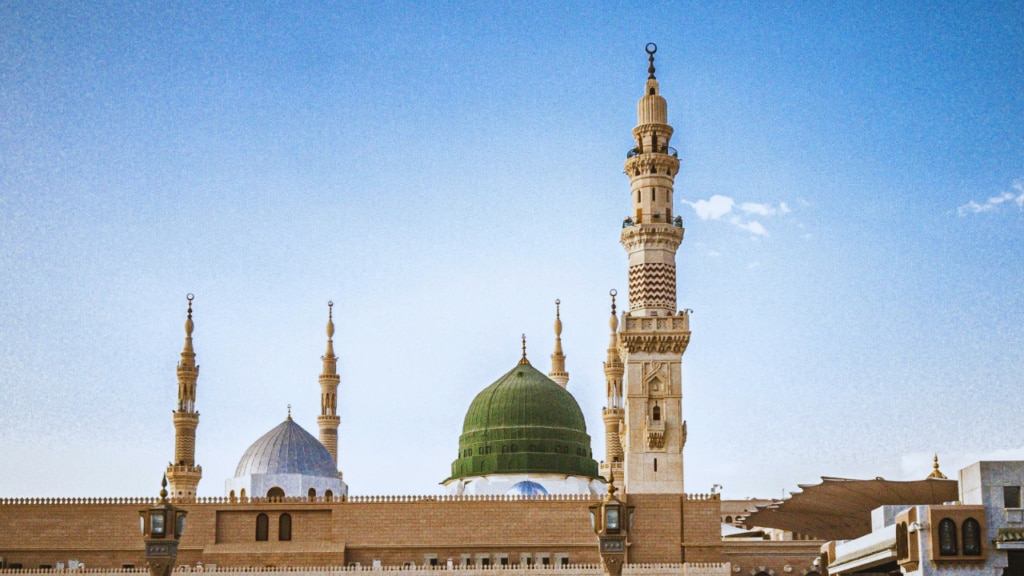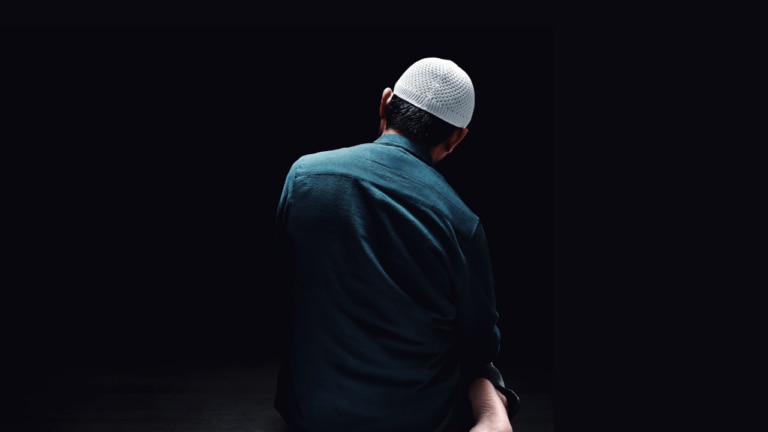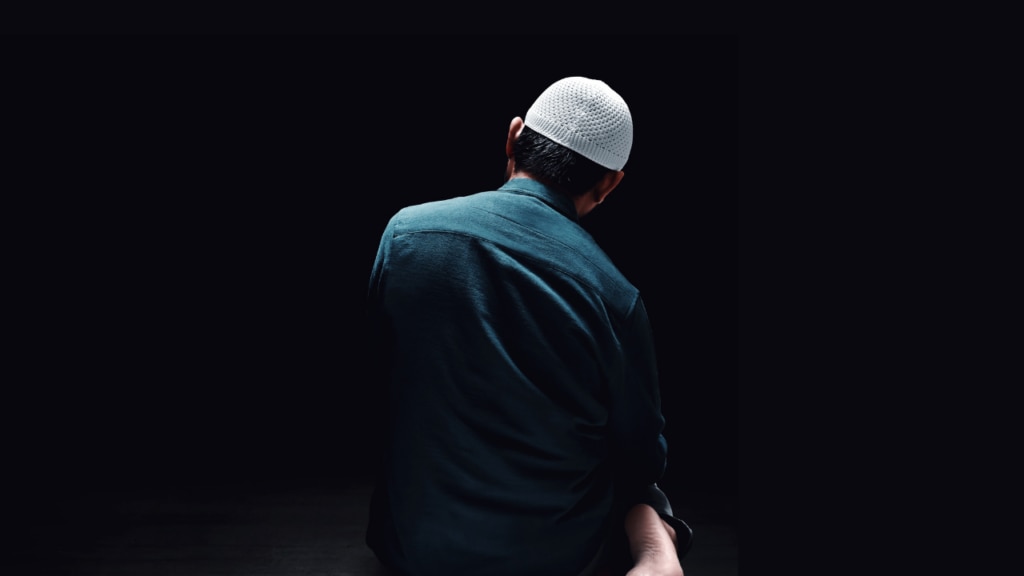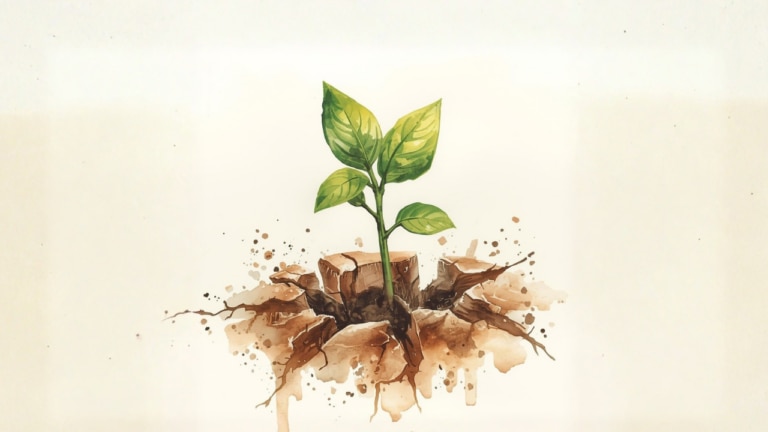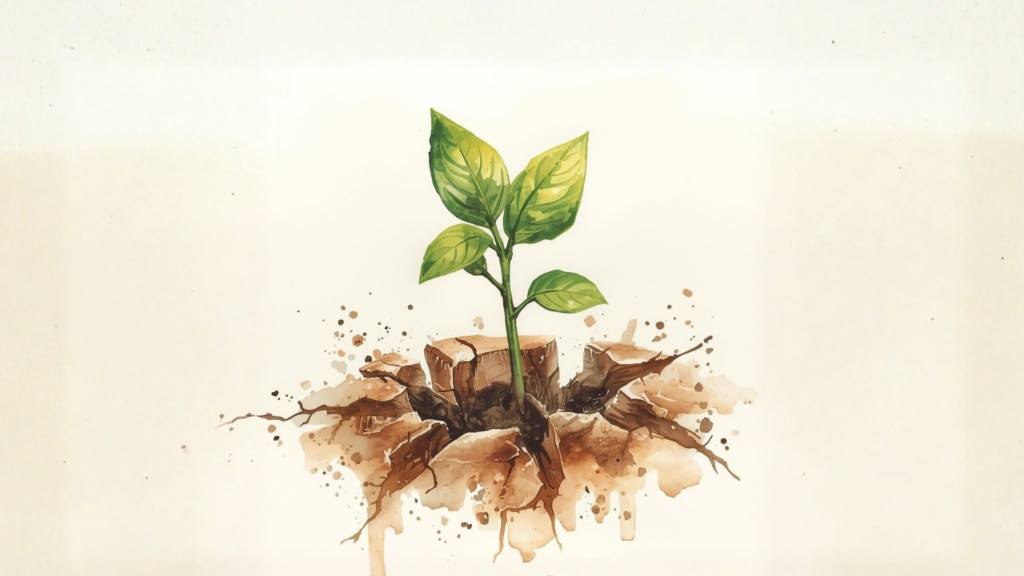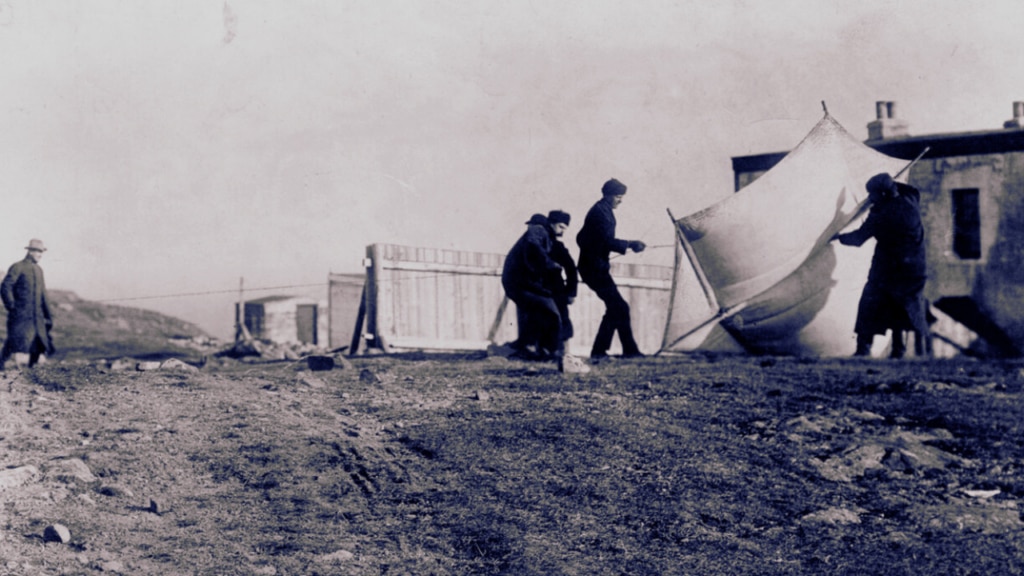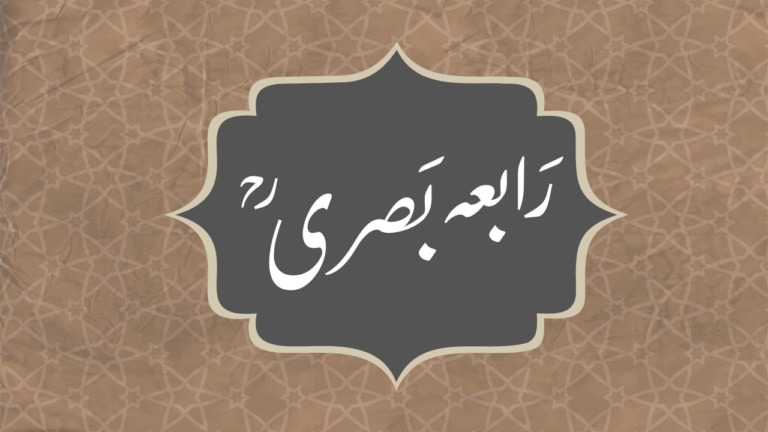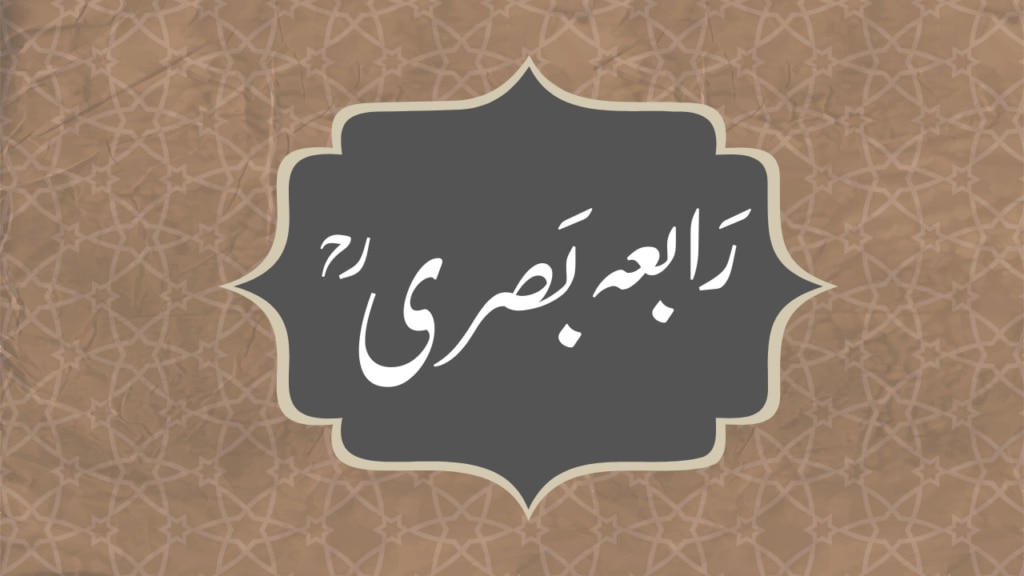Friday Sermon
21 November 2025
Muhammadsa: The great exemplar
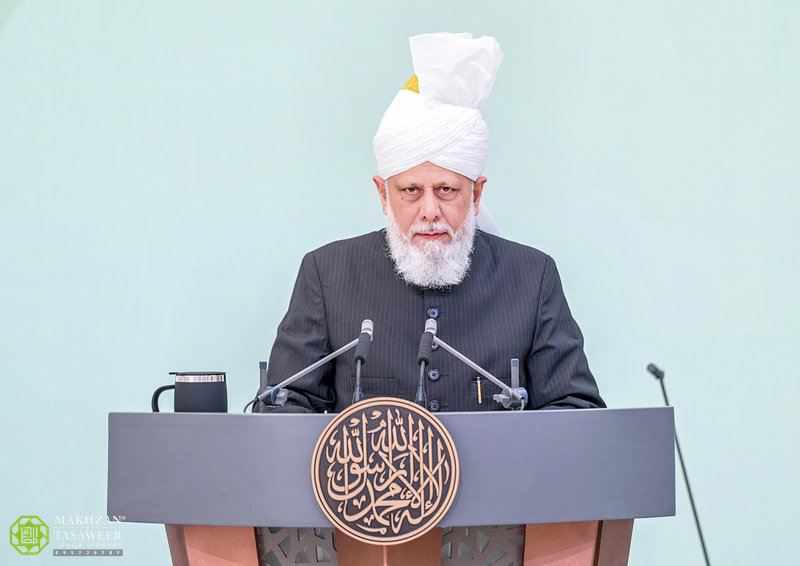
After reciting the tashahhud, ta‘awwuz, and Surah al-Fatihah, Hazrat Khalifatul Masih Vaa stated:
Accounts relating to the Battle of Tabuk were being mentioned. Today, I will mention further details of this journey. The attempt of the hypocrites to harm the Holy Prophetsa on this occasion has also been recorded. These details are as follows.
In relation to the Battle of Tabuk, behind the scenes, a joint conspiracy was being hatched by the Jews, the Christians and the hypocrites. When all their schemes failed and when they were unsuccessful in putting an end to Islam and the Holy Prophetsa, as they had tried to assassinate the Holy Prophetsa on several occasions, this conspiracy was their last resort. And if, as before, divine help and succour would not be [with the Muslims], there is no doubt that this conspiracy of the hypocrites would prove to be most successful. The reason for this is that at every stage, the destruction of the Muslims was certain. We have already observed this in their previous attempts. However, the same God Who granted the Muslims an unimaginable triumph in the battlefield of Badr and Whose continuous help and succour made the Muslims triumphant all the way until the Battle of Hunain would help them again. At every occasion of danger, the very protection of Allah the Almighty was with the Holy Prophetsa. Similar incidents occurred on this occasion.
The journey from Madinah to Tabuk was equivalent to travelling into the valley of death. Travelling safely to Tabuk and back was sufficient to leave the hypocrites utterly stunned. Furthermore, the retreat of the army supported by the Emperor of Rome, or for them not to come forward to confront [the Muslims], was another astonishing fact. Additionally, all the opposing powers living on the borders of Arabia became terrified and subsequently, most of them came to the Holy Prophetsa, sought reconciliation, paid the jizya and considered this the means for their protection. From all these incidents, the conspiracies of the hypocrites seem to have been reduced to dust. The reason for this is that the hypocrites could not even have imagined that any Muslim could have safely returned to Medina alongside the Holy Prophetsa.
As such, when this army of 30,000 soldiers waves its flags of victory and [divine] support and sets off to return to Medina under the leadership of its beloved Prophetsa, the hypocrites considered it essential to shoot the last arrow in their quiver, and that was to prevent the Holy Prophetsa in any way possible from returning to Medina, God forbid. To achieve this, they conspired to assassinate the Holy Prophetsa. In fact, it is not far-fetched to say that this had been pre-planned as a final blow. That is, their first [conspiracy] was that the Muslims would die on the journey, or in Tabuk. However, if they survived and started returning, they would be killed on the way. This opinion could be true, as not all of the leaders of the hypocrites were with them. Rather, a party of the hypocrites was with them, which did not leave any stone unturned in spreading vicious propaganda against the Muslims on every occasion. However, they could not have taken such a big step if this had not been pre-planned.
In any case, they acted upon this dangerous conspiracy in the following manner. On the journey back, there was a path in the valley which was divided into two. One was a wide, open field, and the other was a narrow path, a passage through a rugged, elevated valley.
This was also a shortcut, and the Muslim army had to pass through this mountain pass. The hypocrites devised a plan that when the entire army would be passing over the height of the pass – with the huge crowd and large number of people – they would use the darkness of the night (as the journey was happening at night). At that moment, all these hypocrites would gather near the Holy Prophet’ssa camel and somehow force his camel towards the edge of the pass and cut the ropes of the saddle. In this way, the camel would throw – God forbid – the Holy Prophetsa into the ravine, into the pit below, or fall in itself along with him. And in the darkness of the night, it would be assumed to be an accident, and no one would suspect a planned assassination.
Hazrat Urwah bin Zubair relates that when the Messengersa of Allah left Tabuk to return to Medina, a group of hypocrites intended to kill him. They had planned that they would throw him from the top of a mountain pass along the route. However, at the exact moment, Allah Almighty informed the Holy Prophetsa of the hypocrites’ plot. The Holy Prophetsa then had it announced that no one was to use the mountain pass except the Holy Prophetsa and three of his Companions. He said, “Only I will go through the pass; everyone else will go through the open valley.”
The Companions who accompanied him were Hazrat Hudhaifah bin Yaman, Hazrat Hamzah bin Amr Aslami, and Hazrat Ammar bin Yasir.
As for the rest of the army, they were to pass through a wide open plain in the valley.
Because of this sudden change of route, the hypocrites’ plan appeared to be ruined. Yet even then, they did not give up their evil intention. They immediately selected twelve or fifteen men and agreed that they would cover their faces with cloths, rush towards the mountain pass, and, according to their earlier plan, suddenly scare the camel, causing it to bolt. Their aim – God forbid – was to cause the very accident they had been hoping for.
And so, they proceeded with this plan. As the Holy Prophetsa was walking along the pass, he heard the sound of people approaching. They came near and frightened his camel, causing some of the luggage to fall. The Holy Prophetsa then instructed Hazrat Hudhaifah to attack these hypocrites and drive them away. Hazrat Hudhaifah began striking their mounts with a stick and saying, “Enemies of Allah, move aside!” He continued striking their animals.
The hypocrites realised that the Holy Prophetsa had become aware of their scheme, and they did not want to be recognised. Therefore, they quickly descended from the pass and blended into the army.
Hazrat Hudhaifah returned to the Holy Prophetsa. The Holy Prophetsa said, “Hudhaifah, strike my camel from behind, for it has become frightened, and O Ammar, guide it from the front (so that this startled camel regains its proper course).”
In one narration, Hazrat Hudhaifah relates, “When we reached the mountain pass, twelve men confronted the Holy Prophetsa in that pass. When I informed the Messengersa of Allah, he called out to them. At this, they turned their backs and fled. The Messengersa of Allah then said to us, ‘Did you recognise them?’ We submitted, ‘O Messengersa of Allah, we did not recognise them, because they had covered their faces and it was dark. But we recognised their mounts.’ (The Arabs were also very good at recognising people’s mounts.) He said, ‘These people will remain hypocrites until the Day of Resurrection. And do you know what their intention was?’”
Then he enquired from the Companions who were with him in relation to this. He further relates, “We submitted, ‘No, we do not know [who they are].’ The Messengersa of Allah said, ‘They intended to confront the Messenger of Allah in the pass and cause him to fall there.’
We submitted, ‘Will you not send a message to their tribes, instructing each tribe to send you the head of their man (so they may be punished or executed)?’ The Holy Prophetsa replied, ‘No. I do not want the Arabs to start saying among themselves that Muhammadsa has begun killing his own people.’”
According to some narrations, the Holy Prophetsa was still on his camel when revelation descended upon him. Hazrat Hudhaifah was standing nearby. The Holy Prophetsa called out, “Who is there?” He replied, “Hudhaifah.” The Holy Prophetsa then said, “I am going to tell you something in confidence. Do not mention it to anyone.” He then gave the names of each of the attackers one by one and added, “I have been forbidden from offering their funeral prayer. They are hypocrites.”
According to various narrations, the Holy Prophetsa named twelve, or thirteen, or fifteen individuals. Because the Holy Prophetsa had instructed Hazrat Hudhaifah not to reveal this secret to anyone, Hazrat Hudhaifah never disclosed the names to anyone. Even during the Khilafat of Hazrat Umarra, when Hazrat Umarra learned that Hudhaifah knew the identities, he adopted the following method: whenever someone passed away, and Hazrat Umarra had a suspicion that the deceased might be among those individuals, he would take Hudhaifah by the arm and bring him along to the funeral. If Hudhaifah refused to attend the funeral prayer, Hazrat Umarra would understand that this was one of those people, and he too would refrain from attending the funeral prayer.
According to a narration in Sahih Muslim, there were 14 or 15 [hypocrites], but it has also been explained that 12 of them were hypocrites who took part in this plot, and the other three were Companions who had climbed the pass at that time, but they had not heard the announcer call out that the open plain field should be taken instead of this route. Due to this, these three people were considered innocent.
In the morning, the chief of the Aus tribe, Hazrat Usaid bin Hudair, met with the Holy Prophetsa. The Holy Prophetsa told him that the previous night, some hypocrites intended to follow the Holy Prophetsa in the mountain pass, cut his camel’s reins in the darkness of the night, and poke it with something sharp to cause it to run fast in hopes of making him fall off the camel. Upon this, Hazrat Usaid said, “O Messengersa of Allah, give every tribe the order to kill any person who was part of this plot.” He very passionately continued, “O Messengersa of Allah, will such people be left to roam freely? How much longer will we go without taking action against them, despite the fact that the hypocrites are fewer in number today and have been disgraced, while Islam has become firmly established?” The Holy Prophetsa replied, “I do not like for people to say that ‘once the battle between myself and the disbelievers concluded, Muhammad began killing his Companions’.” Hazrat Usaid said, “O Messengersa of Allah, these people are not companions. (How could they be considered to be from among your Companions?)” The Holy Prophetsa said, “Do they not profess the Islamic Creed?” Hazrat Usaidra said, “Indeed, they do, but this declaration doesn’t mean anything. (It is merely superficial; they do not profess the creed in their heart.)”
The Holy Prophetsa said, “Since they profess the Islamic creed (even if they do so superficially), I will not kill them.” (Sahih Muslim, Kitab sifati l-munafiqina wa ahkamihim, Hadith 2779; Subul Al-Huda Wa Al-Rashad, Vol. 5, Dar Al-Kotob Al-Ilmiyah, 1993, p. 466; Al-Bidaya Wa Al-Nihaya, Vol. 3, Part 5, Dar Al-Kotob Al-Ilmiyah, 2001, pp. 20-21; Al-Lu’ Lu’ Al-Maknoon Sirat Encyclopaedia, Vol. 9, Maktabah Dar-ul-Islam, pp. 542-550; Da’irah Ma’arif Sirat Muhammad Rasulullahsa, Vol. 9, Bazm Iqbal, Lahore, pp. 513-515; Ghazwah-e-Tabuk, Bashmil, Nafees Academy, pp. 189-201)
The so-called scholars of today who issue edicts to kill those who profess the Islamic Creed should bear this statement in mind. Hazrat Musleh-e-Maudra states that when the hypocrites of Medina came to know that no fighting had occurred, and that the Holy Prophet Muhammadsa was returning safely, they realised that the secrets of their hypocritical ways had become known to the Holy Prophetsa, and that they would likely not escape punishment now. Thus, they stationed a few men from Medina at a distance along such a path that was extremely narrow, upon which only one rider could pass at a time.
When the Holy Prophetsa approached this area, Allah the Almighty informed him through revelation that ahead, on both sides of the path, enemies were lying in ambush. The Holy Prophetsa instructed one Companion to go ahead and survey. That Companion ordered his mount forward quickly, and when he reached there, he saw some men hiding in exactly the manner that those who lie in ambush would sit. (There are several narrations. This was also a narration quoted by Hazrat Musleh-e-Maudra.) When they saw him approaching, they fled from there. However, the Holy Prophetsa did not deem it appropriate to pursue them. When the Holy Prophetsa returned to Medina, the hypocrites who had not taken part in the battle began presenting varying excuses, and the Holy Prophetsa accepted their excuses. But now the time had come for the reality of the hypocrites to be made manifest before the Muslims. (Dibacha Tafsir-ul-Quran, Anwar-ul-Ulum, Vol. 20, p. 362)
In any case, whether the accounts say they were sitting down or if they ran away, the incident of exposing them is one in every [narration]: every effort was made to try and inflict damage to the Holy Prophet Muhammadsa in this narrow gorge (God forbid).
As has been mentioned, following the victory at Mecca, the hypocrites’ movements intensified. And when these hypocrites observed that the surrounding tribes of Arabia – Jewish tribes included – had suffered defeat and lost their power, they began planning to seek the support of powers outside Arabia, like the Caesar of Rome.
They also planned on establishing a permanent headquarters within Medina where they could regularly meet to contrive plans against Islam and the Muslims and store weaponry. But the headquarters should be such that the Muslims never catch any word of it.
Hence, Abu Amir – who for some time had stayed out of the public eye – suddenly started becoming ever-present, and those who spread propaganda in favour of the hypocritical agenda started calling him Abu Amir the Ascetic.
He suggested that the hypocrites establish their headquarters in Quba. History further records that this person was known as Abu Amir the Ascetic and belonged to the Khazraj tribe. This has been mentioned in other sermons as well.
After the Holy Prophetsa came to Medina, Abu Amir relocated to Mecca where he instigated the tribes of the Quraish against the Holy Prophet Muhammadsa, reassuring them that they would have the full support of Abu Amir and his tribesmen, saying, “When you attack Muhammadsa we will join you.”
During the expedition to Uhud, he was with the Quraish. Upon seeing the advancement of Islam, Abu Amir became greatly distressed and began to burn in the fire of jealousy. It was he who had ditches dug on the occasion of Uhud, and the Holy Prophetsa fell into one of them and was badly injured.
When the battle of Uhud commenced, Abu Amir called out to his tribesmen: “O my tribesmen, I am Abu Amir!” But they had become Muslims, and so responded, saying, “O mischief monger, we do not welcome your leadership.” They responded with revulsion and cursed him. Abu Amir responded, “After my departure, my nation has deteriorated.”
After this, many of those who harboured enmity toward the Holy Prophetsa from Abu Amir’s tribe left for Mecca. This actually had taken place before this instance – when Abu Amir left for Mecca, these people also left for Mecca (those who were from his tribe and had not become Muslims). They numbered approximately 50 people. There are narrations in which there is also a mention of a prayer made by the Holy Prophetsa against Abu Amir – that he should die a death of solitude away from his people.
One narration mentions that when the Holy Prophetsa arrived in Medina, Abu Amir met him and asked, “O Muhammad, to what do you invite people?”
Upon this, the Messengersa of Allah replied:
“I invite you to the religion of Abraham – the same faith which you also claim to be searching for.”
Abu Amir asked, “Are you also of that same faith?”
The Holy Prophetsa replied in the affirmative and then invited him to Islam. Abu Amir rejected this invitation. He displayed jealousy and spoke ill of the Holy Prophetsa. Abu Amir mocked the Holy Prophetsa, saying, “Whoever between us is the liar, may God cause him to die alone and outside his homeland.”
He was indicating toward the Holy Prophetsa.
The Holy Prophetsa responded, “Yes, may God do so with the liar.”
Abu Amir continued to prevent the people of his tribe from following the Holy Prophetsa and kept urging them not to obey him. Meanwhile, the signs and miracles of the Holy Prophetsa were appearing increasingly with each passing day, and the number of his followers continued to grow – particularly among the very people of Abu Amir’s own tribe, who were entering Islam. Seeing this, Abu Amir became all the more enraged.
He joined hands with the hypocrites and built a mosque, which in the history of Islam came to be known as Masjid Dirar, so that he could gather people there, converse with them, and dissuade them from following the Holy Prophetsa. According to one narration, Abu Amir said to his fellow conspirators, “Build a mosque and establish it as a military base where you can prepare for war. I will go to Caesar of Rome and return with a vast army so that Muhammad[sa] and his Companions may be driven out of Medina.”
Thus, Abu Amir departed for the Roman Empire and met the Roman emperor, Caesar, in Syria. He tried to persuade him to wage war against the Holy Prophetsa and the Muslims, saying: “They are weak, poor, and few in number, whereas their enemies are many. You have nothing to fear from them. But if you do not take action against the Muslims now, it will not bode well for your empire in the future.”
Heraclius accommodated him and promised that he would indeed assist him. During this time, Abu Amir conveyed glad tidings to his co-religionists and immoral conspirators, saying that he would soon attack Medina with a mighty army. Therefore, he told them they should build a special place for him. With this intention, the hypocrites constructed a mosque in Quba – the mosque which came to be known as Masjid Dirar.
However, even this desire of his was never fulfilled. In the end, Abu Amir died alone in a foreign land, in a state of exile in Syria. He had prayed against the Holy Prophetsa, but that very curse turned back upon himself. There is a difference of opinion regarding the year of his death – some say he died in 9 AH, while others say in 10 AH – but in any case, he died in utter isolation. (Tathbit Dalail-ul-Nabuwwah, Vol. 2, Maktabat-ul-Nashir, Dar-ul-Mustafa, Cairo, p. 475; Sharah Allamah Al-Zurqani Ala’ Al-Mawahib Al-Ladunniyyah, Vol. 2, Dar Al-Kotob Al-Ilmiyah, 1996, p. 424; Al-Lu’ Lu’ Al-Maknoon Sirat Encyclopaedia, Vol. 9, Maktabah Dar-ul-Islam, pp. 552-554)
When the hypocrites completed the construction of the mosque, they came to the Holy Prophetsa and requested him to offer prayers in it. By divine wisdom, they came with this request for the inauguration of their so-called mosque at the very time when the Holy Prophetsa was preparing to set out for the expedition to Tabuk.
They said, “O Messengersa of Allah, we have built a mosque for the convenience of the sick and the needy, and for rainy nights. We wish that you would come and lead a prayer in it.”
The Holy Prophetsa replied, “I am occupied at the moment, preparing for the journey. When we return from the expedition, we shall pray there.”
When the Holy Prophetsa returned from the Battle of Tabuk and camped at a place called Dhi Awan, which was about an hour’s distance from Medina, the following verse was revealed concerning the mosque built by the hypocrites:
وَالَّذِينَ اتَّخَذُوا مَسْجِدًا ضِرَارًا وَكُفْرًا وَتَفْرِيقًا بَيْنَ الْمُؤْمِنِينَ وَإِرْصَادًا لِمَنْ حَارَبَ اللَّهَ وَرَسُولَهُ مِنْ قَبْلُ ۚ وَلَيَحْلِفُنَّ إِنْ أَرَدْنَا إِلَّا الْحُسْنَىٰ وَاللَّهُ يَشْهَدُ إِنَّهُمْ لَكَاذِبُونَ
“And among the hypocrites are those who have built a mosque in order to injure Islam and help disbelief and cause a division among the believers, and prepare an ambush for him who warred against Allah and His Messenger before this. And they will surely swear: ‘We meant nothing but good,’ but Allah bears witness that they are certainly liars.” [The Holy Quran, 9:107]
After this revelation, the Holy Prophetsa summoned Hazrat Malik bin Dukhsham and Hazrat Ma’n bin ‘Adi and commanded them to demolish Masjid Dirar.
According to some narrations, the Holy Prophetsa also sent Hazrat Asim bin ‘Adi, ‘Amir bin Sakan, Wahshi – the slayer of Hazrat Hamzah – and Suwayd bin ‘Abbas for this task.
In Sharh al-Zurqani, it is written that it is possible the Holy Prophetsa first sent the two men and later dispatched four more to assist them.
In any case, the Holy Prophetsa instructed them to proceed towards Masjid Dirar, demolish it, and set it ablaze.
Accordingly, they quickly went to the tribe of Banu Salim. Hazrat Malik said to his two Companions, “Wait for me until I return.” He went to his house, set fire to some dry palm branches, and brought them back. When they reached Masjid Dirar between Maghrib and Isha prayers, they set it on fire and razed it to the ground.
At that time, the builders of the mosque were present there, but when the fire broke out, they fled in all directions.
When the Holy Prophetsa returned to Medina, he intended to grant that site to Hazrat Asim bin ‘Adi, telling him to build his house there. But Asim bin ‘Adi excused himself, saying, “Whatever Allah the Almighty had to reveal concerning this place, He has revealed. I do not wish to make my home here, nor do I need it. Rather, grant it to Thabit bin Akram, for he has no house.”
The Holy Prophetsa then granted that land to Thabit bin Akram.
Ibn Ishaq has mentioned the names of those hypocrites who had built Masjid Dirar, and they numbered twelve in total. (Sharah Allamah Al-Zurqani Ala’ Al-Mawahib Al-Ladunniyyah, Vol. 2, Dar Al-Kotob Al-Ilmiyah, 1996, p. 424; Subul Al-Huda Wa Al-Rashad, Vol. 5, Dar Al-Kotob Al-Ilmiyah, 1993, p. 466; Al-Sirah Al-Nabawiyyah, Ibn Ishaq, Dar Al-Kotob Al-Ilmiyah Beirut, 2004, pp. 608-609; Al-Lu’ Lu’ Al-Maknoon Sirat Encyclopaedia, Vol. 9, Maktabah Dar-ul-Islam, p. 555)
The Holy Prophet’ssa vast mercy, patience, and forgiveness are luminously evident in this incident. At every step, he was confronted with dangerous conspiracies from the hypocrites – schemes that caused distress, harm, and even plots to kill him. Yet, though these hypocrites were often caught red-handed, the Holy Prophetsa would always forgive them on every occasion.
Only in cases where the security of the state or the integrity of the system was at risk did he take action, and even then only to the extent necessary to neutralise the danger – not to inflict severe punishment, though he easily could have.
Hazrat Musleh-e-Maudra has discussed the conduct of the hypocrites in this regard, stating:
“God Almighty revealed to the Holy Prophetsa through revelation that the mosque in Quba, which the hypocrites had built – so that they might assemble there under the pretext of prayer and hold their hypocritical consultations – should be demolished, and that they should be compelled to pray in the other mosques of the Muslims. Yet, despite so grave a mischief, they were given neither physical nor financial punishment.” (Dibacha Tafsir-ul-Quran, Anwar-ul-Ulum, Vol. 20, pp. 362-363)
The Holy Prophetsa was fully aware of their deeds.
There is another narration in which the Holy Prophetsa expressed love for Medina and for the Ansar: After a journey of approximately two months, the Holy Prophetsa returned to Medina. As he was returning, the love that he had for Medina and its inhabitants was exhibited when, as soon as the Holy Prophetsa caught sight of Medina, he said:
هذِه طَابَةُ، وَهذا أُحُدٌ، جَبَلٌ يُحِبُّنَا وَنُحِبُّهُ.
“This is Tabah (Tabah is also one of the names of Medina, meaning pure and excellent) and this is Uhud, the mountain that loves us and we love it.” (Sahih al-Bukhari, Kitab al-maghazi, Hadith 4422)
In other words, the Holy Prophetsa had love for every part of Medina. Another aspect to this is that with the mention of Uhud, the Holy Prophetsa never forgot the stories of sincerity and loyalty that the Companions had written with their own blood in the Battle of Uhud.
In one narration it is stated that the Holy Prophetsa said: “I must reach Medina quickly, so whoever among you wishes to travel quickly with me should do so.” Then the Holy Prophetsa also said: “Shall I not tell you about the best households among the Ansar?” The Companions replied, “Certainly.” The Holy Prophetsa said, “The households of Banu Najjar.” Then he said, “The households of Banu Abd al-Ash’al.” Then he said, “The households of Banu Sa‘idah, or the households of Banu Harith bin Khazraj. And there is goodness in all the households of the Ansar.” (Sahih al-Bukhari, Kitab az-zakat, Hadith 1481, translation, Vol. 3, pp. 124-125)
In one narration the narrator states: “Sa‘d bin Ubadah met us, and Abu Usaid said, ‘Do you know that the Messengersa of Allah mentioned the excellence of the households of the Ansar and placed us at the end?’ Hazrat Sa‘d went to the Messengersa of Allah and said, ‘O Messengersa of Allah, you have mentioned the excellence of the households of the Ansar and have placed us at the end.’ (The Companions were mindful even of the order in which the Holy Prophetsa mentioned names when giving praise). Upon this, the Holy Prophetsa said, ‘Is it not enough for you that you are among the people of goodness?’” (Sahih al-Bukhari, Kitab manaqibi l-ansar, Hadith 3791; Sahih Muslim, Kitab al-fada’il, Hadith 4216, Translation, Vol. 12, p. 187)
The Holy Prophetsa said that it should suffice that he mentioned their name and included them among the people of goodness.
As mentioned at the outset, there were two major groups who remained behind from the Expedition of Tabuk: one was the group of hypocrites, regarding whom Allah the Almighty expressed His displeasure; and the second group consisted of those who were sincere in their faith and wished to partake in jihad, but either they were so poor that despite their efforts they could not find the means and resources to go, or they were unable to participate because of illness or disability. Allah the Almighty accepted their excuse in the Holy Quran in Surah at-Taubah, verses 91 and 92.
Accordingly, in a narration of Bukhari, it is stated that when the Holy Prophetsa was returning from the Expedition of Tabuk and neared Medina, he said: “There are some people in Medina who were with you whenever you undertook a journey or traversed a valley.” The Companions, astonished, said, “O Messengersa of Allah, they are in Medina, how could they be with us while remaining there?” The Holy Prophetsa replied, “They are indeed in Medina, but some sort of illness or other excuse prevented them from joining us.” (Sahih al-Bukhari, Kitab al-maghazi, Hadith4423)
Another narration states that when the Holy Prophetsa returned from Tabuk, he expressed gratitude to Allah the Almighty and said:
ٱلْحَمْدُ لِلّٰهِ عَلَىٰ مَا رَزَقَنَا فِي سَفَرِنَا هٰذَا مِنْ أَجْرٍ وَحَسَنَةٍ، وَمِنْ بَعْدِنَا شُرَكَاؤُنَا فِيهِ
“All praise belongs to Allah Who granted us reward and goodness in this journey, and Who also included those who remained behind as participants with us in this reward and goodness.”
Hazrat Aishara submitted, “O Messengersa of Allah, you endured the hardships and difficulties of the journey and thus became deserving of this reward, but how did they come to share in this reward without having borne any hardships? And who are these people who have been included?” The Holy Prophetsa replied, “There are some people in Medina who were with us no matter where we travelled and no matter which valley we were in. Illness prevented them from going out with us. We are their warriors, and they are our companions while remaining in their homes. By Him in Whose hand is my life, their prayer against the enemy is more effective than our weapons.” The prayers they offered while remaining in their homes were such that Allah the Almighty accepted them. (Anara-tul-Duja Fi Maghazi Khair-ul-Wara, Vol. 1, Dar-ul-Minhaj, pp. 721-722; Imta’ ul Asma’, Vol. 2, Dar Al-Kotob Al-Ilmiyah, 1999, p. 79; Kitab-ul-Maghazi, Waqdi, Vol. 2, Dar Al-Kotob Al-Ilmiyah, 2004, p. 428)
Regarding the return from the Expedition of Tabuk, there is also mention of the heartfelt manner in which the people of Medina welcomed them back. It is recorded that when the Holy Prophetsa returned from Tabuk, the people of Medina, including men, women, and children, went to Thaniyah al-Wada, just outside of Medina, as they brimmed with love for the Holy Prophetsa and longed to see him and be in his blessed presence. There, they recited the following couplets:
طَلَعَ ٱلْبَدْرُ عَلَيْنَا مِنْ ثَنِيَّاتِ ٱلْوَدَاع وَجَبَ ٱلشُكْرُ عَلَيْنَا مَا دَعَا لِلّٰهِ دَاعَ
“The full moon has risen upon us from the valley of Thaniyah al-Wada. Gratitude to Allah has become obligatory upon us, so long as there remains anyone who calls unto Allah.”
The people of Medina reciting these couplets in deep love for the Holy Prophetsa is mentioned in two instances: one, when the Holy Prophetsa migrated from Mecca to Medina; and the second, when the Holy Prophetsa entered Madinah upon returning from Tabuk. Some commentators of Hadith, such as Allamah Ibn Hajar Asqalani, a commentator of Bukhari, are of the opinion that it is entirely possible that the couplets mentioned in the narration from Hazrat Aishara relate to the time when the Holy Prophetsa returned from the Expedition of Tabuk, because at that time, the people and the children welcomed the Holy Prophetsa at Thaniyah al-Wada, since those arriving from the direction of Syria were received at that location.
When the people of Medina learned of the Holy Prophet’ssa safe return from Tabuk, they came out joyfully to welcome him outside Medina at Thaniyah al-Wada, just as Hazrat Sa’ib bin Yazid narrates: “I remember that I too went with the other children to Thaniyah al-Wada to welcome the Holy Prophetsa when he was returning from the Expedition of Tabuk.” Imam Baihaqi has also recorded that the children welcomed the Holy Prophetsa with these very couplets when he returned to Medina from the Expedition of Tabuk. (Sirat Khatam-un-Nabiyyeen, Hazrat Mirza Bashir Ahmad Sahibra MA, p. 267; Justajoo-e-Madinah, Abdul Hameed Qadri, Oriental Publications, 2007, pp. 403-404; Mu’jam-ul-Buldan, Vol. 2, Dar Al-Kotob Al-Ilmiyah, p. 100)
In any case, it is entirely possible that these couplets were recited on both occasions. However, the likelihood of their being recited upon the return from Tabuk is greater because, as mentioned, the people of Medina, overwhelmed with emotion, would have come out in overflowing love to behold and welcome the Holy Prophetsa. It has been described that this journey was one regarding which the hypocrites had spread such rumours that when the good news was received that the Holy Prophetsa and the Companions had returned safely, it was as though dried crops had received rain. On this joyous occasion, the Muslims of Medina, including the children and elderly, women and men, all came out to welcome the Holy Prophetsa.
In any case, it is very possible that these couplets were also recited upon the migration from Mecca, and expressions of love could certainly have occurred on both occasions; there is no need for debate in this regard. However, it is established that after arriving in Medina, the realisation and depth of love that the Muslims attained for the Holy Prophetsa was far greater than what they had previously possessed at the time of the migration.
Insha-Allah, I will mention some other incidents and aspects from the life of the Holy Prophetsa in the future.
(Official Urdu transcript published in the Daily Al Fazl International, 12 December 2025, pp. 2-7. Translated by The Review of Religions.)







